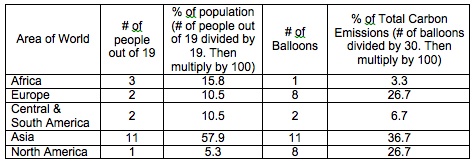Carbon Dioxide Emissions
Summary
This demonstration shows students the amount of carbon dioxide emitted by different areas of the world. It also has them brainstorm ways we can reduce the amount of carbon we use everyday.
Materials
Attachments
- 30 black balloons (if you have a small room, get small balloons)
- any objects you want to use as props for each country
- student sheets (attached)
- calculators
Background for Teachers
This is a good introductory activity to carbon emissions. It shows students the amount of carbon dioxide emitted by different areas of the world. It also has them brainstorm ways we can reduce the amount of carbon we use everyday.
Instructional Procedures
- Inflate all 30 balloons ahead of time and keep them hidden away from students until it is time to use them. Designate an area of the room for each continent being used (Africa, Europe, Central and South America, North America, and Asia) and set up props to represent each one (flags, travel posters, artifacts, etc.).
- Hand out student sheets. Read through the introduction with the students. Discuss with the students the difference between industrial emissions and the photosynthesis/respiration cycle. Discuss with students whether or not different lifestyles would result in the use of more carbon dioxide.
- Have the students stand up and go to the area of the world they think has the highest population. Now have students go to the area of the world they think has the lowest population. Next have students go to the area of the world they think emits the most carbon dioxide. Then have them go to the area of the world they think emits the least carbon dioxide. Have all but 19 students return to their seats.
- With the 19 remaining students, send them to the following areas of the world: Africa-3 people, Europe-2, Central & South America-2, Asia- 11, North America-1.
- Tell the students that the black balloons demonstrate the amount of carbon emissions from each area of the world. Distribute the balloons as follows: Africa- 1 balloon, Europe- 8, North America- 8, Central & South America- 2, Asia- 11.
- Collect the balloons and have students go back to their seats. Have students answer their questions.
Assessment Plan
Attachments
Scoring Guide:
1. Students participate in demonstration………………………….. 4
2. Students complete the data table……………………………….. 4
3. Students complete the analysis and conclustion…………….... 4
Answers to Questions:
Data table:

- Asia
- North America
- Asia
- 5.3%
- 26.7%, Yes
- The amount of carbon in the air would increase even faster and the levels of air pollution would sky rocket.
- Opinion
- Transportation, Food, and household operations.
- Answers will vary: Car pool, take public transportation, find alternative energy sources, walk, bike, combine needed trips (stop at store on the way home instead of going out again), etc.
- Turn off lights when not in use, unplug appliances not being used, use fluorescent light bulbs, use landscape to help reduce energy costs, etc.
- Buy food grown and manufactured locally, plant a garden, buy organic, recycle packaging, use reusable shopping bags, etc.
Bibliography
Lesson Design by Jordan School District Teachers and Staff.
Updated: 02/03/2018


 UTAH EDUCATION NETWORK
UTAH EDUCATION NETWORK

 Justin
Justin Braxton
Braxton Dani
Dani Kayla
Kayla Katie
Katie Matthew
Matthew Rob
Rob Val
Val
